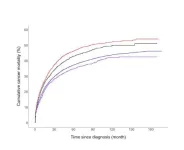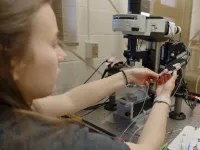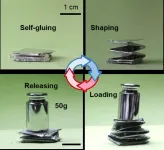(Press-News.org) CAMBRIDGE, MA — Huge libraries of drug compounds may hold potential treatments for a variety of diseases, such as cancer or heart disease. Ideally, scientists would like to experimentally test each of these compounds against all possible targets, but doing that kind of screen is prohibitively time-consuming.
In recent years, researchers have begun using computational methods to screen those libraries in hopes of speeding up drug discovery. However, many of those methods also take a long time, as most of them calculate each target protein’s three-dimensional structure from its amino-acid sequence, then use those structures to predict which drug molecules it will interact with.
Researchers at MIT and Tufts University have now devised an alternative computational approach based on a type of artificial intelligence algorithm known as a large language model. These models — one well-known example is ChatGPT — can analyze huge amounts of text and figure out which words (or, in this case, amino acids) are most likely to appear together. The new model, known as ConPLex, can match target proteins with potential drug molecules without having to perform the computationally intensive step of calculating the molecules’ structures.
Using this method, the researchers can screen more than 100 million compounds in a single day — much more than any existing model.
“This work addresses the need for efficient and accurate in silico screening of potential drug candidates, and the scalability of the model enables large-scale screens for assessing off-target effects, drug repurposing, and determining the impact of mutations on drug binding,” says Bonnie Berger, the Simons Professor of Mathematics, head of the Computation and Biology group in MIT’s Computer Science and Artificial Intelligence Laboratory (CSAIL), and one of the senior authors of the new study.
Lenore Cowen, a professor of computer science at Tufts University, is also a senior author of the paper, which appears this week in the Proceedings of the National Academy of Sciences. Rohit Singh, a CSAIL research scientist, and Samuel Sledzieski, an MIT graduate student, are the lead authors of the paper, and Bryan Bryson, an associate professor of biological engineering at MIT and a member of the Ragon Institute of MGH, MIT, and Harvard, is also an author. In addition to the paper, the researchers have made their model available online for other scientists to use.
Making predictions
In recent years, computational scientists have made great advances in developing models that can predict the structures of proteins based on their amino-acid sequences. However, using these models to predict how a large library of potential drugs might interact with a cancerous protein, for example, has proven challenging, mainly because calculating the three-dimensional structures of the proteins requires a great deal of time and computing power.
An additional obstacle is that these kinds of models don’t have a good track record for eliminating compounds known as decoys, which are very similar to a successful drug but don’t actually interact well with the target.
“One of the longstanding challenges in the field has been that these methods are fragile, in the sense that if I gave the model a drug or a small molecule that looked almost like the true thing, but it was slightly different in some subtle way, the model might still predict that they will interact, even though it should not,” Singh says.
Researchers have designed models that can overcome this kind of fragility, but they are usually tailored to just one class of drug molecules, and they aren’t well-suited to large-scale screens because the computations take too long.
The MIT team decided to take an alternative approach, based on a protein model they first developed in 2019. Working with a database of more than 20,000 proteins, the language model encodes this information into meaningful numerical representations of each amino-acid sequence that capture associations between sequence and structure.
“With these language models, even proteins that have very different sequences but potentially have similar structures or similar functions can be represented in a similar way in this language space, and we're able to take advantage of that to make our predictions,” Sledzieski says.
In their new study, the researchers applied the protein model to the task of figuring out which protein sequences will interact with specific drug molecules, both of which have numerical representations that are transformed into a common, shared space by a neural network. They trained the network on known protein-drug interactions, which allowed it to learn to associate specific features of the proteins with drug-binding ability, without having to calculate the 3D structure of any of the molecules.
“With this high-quality numerical representation, the model can short-circuit the atomic representation entirely, and from these numbers predict whether or not this drug will bind,” Singh says. “The advantage of this is that you avoid the need to go through an atomic representation, but the numbers still have all of the information that you need.”
Another advantage of this approach is that it takes into account the flexibility of protein structures, which can be “wiggly” and take on slightly different shapes when interacting with a drug molecule.
High affinity
To make their model less likely to be fooled by decoy drug molecules, the researchers also incorporated a training stage based on the concept of contrastive learning. Under this approach, the researchers give the model examples of “real” drugs and imposters and teach it to distinguish between them.
The researchers then tested their model by screening a library of about 4,700 candidate drug molecules for their ability to bind to a set of 51 enzymes known as protein kinases.
From the top hits, the researchers chose 19 drug-protein pairs to test experimentally. The experiments revealed that of the 19 hits, 12 had strong binding affinity (in the nanomolar range), whereas nearly all of the many other possible drug-protein pairs would have no affinity. Four of these pairs bound with extremely high, sub-nanomolar affinity (so strong that a tiny drug concentration, on the order of parts per billion, will inhibit the protein).
While the researchers focused mainly on screening small-molecule drugs in this study, they are now working on applying this approach to other types of drugs, such as therapeutic antibodies. This kind of modeling could also prove useful for running toxicity screens of potential drug compounds, to make sure they don’t have any unwanted side effects before testing them in animal models.
“Part of the reason why drug discovery is so expensive is because it has high failure rates. If we can reduce those failure rates by saying upfront that this drug is not likely to work out, that could go a long way in lowering the cost of drug discovery,” Singh says.
###
The research was funded by the National Institutes of Health, the National Science Foundation, and the Phillip and Susan Ragon Foundation.
END
New model offers a way to speed up drug discovery
By applying a language model to protein-drug interactions, researchers can quickly screen large libraries of potential drug compounds.
2023-06-09
ELSE PRESS RELEASES FROM THIS DATE:
Black, Hispanic survivors of breast cancer have higher death rates from second cancers
2023-06-09
Hispanic and non-Hispanic Black female survivors of breast cancer experience higher death rates after being diagnosed with a second primary cancer than members of other ethnic and racial groups, according to recent research from investigators at the Johns Hopkins Kimmel Cancer Center.
In a study of nearly 40,000 adult survivors of breast cancer, the risk of death from a second cancer was 12% higher among non-Hispanic Black survivors and 8% higher among Hispanic survivors compared with non-Hispanic white survivors. Survivors in racial and ethnic minorities were diagnosed with second cancers ...
Mouse models of adolescent binge drinking reveal key long-lasting brain changes
2023-06-09
UNIVERSITY PARK, Pa — Heavy alcohol consumption may cause permanent dysregulation of neurons, or brain cells, in adolescents, according to a new study in mice. The findings suggest that exposure to binge-levels of alcohol during adolescence, when the brain is still developing, lead to long-lasting changes in the brain’s ability to signal and communicate — potentially setting the stage for long-term behavioral changes and hinting towards the mechanisms of alcohol-induced cognitive changes in humans.
“What we’re seeing here,” said Nikki Crowley, assistant professor in biology and biomedical engineering ...
Infants and toddlers up to 5 years old can participate in Shape Up! Keiki study at Pennington Biomedical
2023-06-09
The Pennington Biomedical Research Center is looking for children 5 years old and younger to participate in the Shape Up! Keiki research study. The purpose of the Shape Up! Keiki research study is to create a better way to measure and describe health from body shape.
“Parents can learn more about their child’s health by joining the Shape Up! Keiki study, while also providing important information that will help us find quick ways to measure obesity status and health based on a child’s body ...
Seenu Hariprasad named University of Chicago Chair of Ophthalmology and Visual Science
2023-06-09
Seenu M. Hariprasad, MD, the Shui-Chin Lee Professor of Ophthalmology, will be appointed Chair of the Department of Ophthalmology and Visual Science, effective July 1, 2023. He has been serving as Interim Chair since 2020.
Hariprasad is an internationally recognized vitreoretinal surgeon who originally joined the University of Chicago in 2005. Over the course of his career, he has developed a strong track record as a clinician, surgeon, researcher, educator, and leader in his department. He is a leading specialist in various vitreoretinal disorders, including macular degeneration, diabetic ...
Liquid metal sticks to surfaces without a binding agent
2023-06-09
Everyday materials such as paper and plastic could be transformed into electronic “smart devices” by using a simple new method to apply liquid metal to surfaces, according to scientists in Beijing, China. The study, published June 9 in the journal Cell Reports Physical Science, demonstrates a technique for applying a liquid metal coating to surfaces that do not easily bond with liquid metal. The approach is designed to work at a large scale and may have applications in wearable testing platforms, flexible devices, and soft robotics.
“Before, we thought that it was impossible for liquid metal ...
Estimated reductions in opioid overdose deaths with public health interventions
2023-06-09
About The Study: In this decision analytical model study of the opioid epidemic in four U.S. states, sustained implementation of interventions, including increased delivery of medications for opioid use disorder and naloxone supply, was found to be needed to reduce opioid-related overdose deaths and prevent deaths from increasing again.
Authors: Jagpreet Chhatwal, Ph.D., of Massachusetts General Hospital in Boston, is the corresponding author.
To access the embargoed study: Visit our For The Media website at this link https://media.jamanetwork.com/
(doi:10.1001/jamanetworkopen.2023.14925)
Editor’s Note: Please see ...
Racial, ethnic, sex differences in methadone-involved overdose deaths before, after federal policy change expanding take-home methadone doses
2023-06-09
About The Study: In this study of monthly methadone-involved overdose deaths, the take-home policy may have helped reduce deaths for Black and Hispanic men but had no association with deaths of Black or Hispanic women or white men or women. The urgency of the overdose crisis requires that national methadone policy debates and decisions address the heterogeneity of people in treatment; relaxing methadone restrictions may help some particularly at-risk groups.
Authors: Rebecca Arden Harris, M.D., M.Sc., of the University of Pennsylvania in Philadelphia, is the corresponding author.
To ...
Graphene-based Carbocatalysts: Synthesis, Properties, and Applications—Beyond Boundaries
2023-06-09
Introducing "Graphene-based Carbocatalysts: Synthesis, Properties, and Applications (Volume 2)"—a concise yet comprehensive compendium for the scientific community, professors, and students alike. This authoritative volume - published by Bentham Science - delves into the forefront of Graphene-based carbocatalysis, providing a wealth of factual knowledge and exploration. The book opens with an in-depth analysis of electrocatalysis by Graphene materials, unraveling the intricate relationship between Graphene and electrochemical reactions. It sheds light on the catalytic prowess exhibited by Graphene-based materials, offering promising avenues for advancing energy ...
Aston University wins £1.8m to boost West Midlands low carbon markets
2023-06-09
Aston University and local industry to develop technology to convert organic material into commercially valuable products
Sawdust, diseased trees and dried chicken litter among what can be transformed into sustainable bioproducts
West Midlands companies are invited to join a cluster to develop new low carbon products for growing markets.
Aston University is to receive £1.8 million to transform the West Midlands into a powerhouse of low-carbon product development and commercialisation.
The University will be building on its existing research facilities to lead the region’s Biochar CleanTech Accelerator as part of the West Midlands Innovation Accelerator.
The project ...
Price vs. health: Food shoppers choose price
2023-06-09
Key Takeaways:
When food consumers are properly incentivized, they will choose healthier options.
When financial incentives are removed, consumers are more likely to choose less healthy options by comparison.
BALTIMORE, MD, June 9, 2023 – A new study of food consumer shopping behaviors has found that when faced with a choice – lower prices or healthier foods – they will likely choose lower prices.
The study found that when you give food consumers temporary incentives to buy ...
LAST 30 PRESS RELEASES:
Why some brains switch gears more efficiently than others
UVA’s Jundong Li wins ICDM’S 2025 Tao Li Award for data mining, machine learning
UVA’s low-power, high-performance computer power player Mircea Stan earns National Academy of Inventors fellowship
Not playing by the rules: USU researcher explores filamentous algae dynamics in rivers
Do our body clocks influence our risk of dementia?
Anthropologists offer new evidence of bipedalism in long-debated fossil discovery
Safer receipt paper from wood
Dosage-sensitive genes suggest no whole-genome duplications in ancestral angiosperm
First ancient human herpesvirus genomes document their deep history with humans
Why Some Bacteria Survive Antibiotics and How to Stop Them - New study reveals that bacteria can survive antibiotic treatment through two fundamentally different “shutdown modes”
UCLA study links scar healing to dangerous placenta condition
CHANGE-seq-BE finds off-target changes in the genome from base editors
The Journal of Nuclear Medicine Ahead-of-Print Tip Sheet: January 2, 2026
Delayed or absent first dose of measles, mumps, and rubella vaccination
Trends in US preterm birth rates by household income and race and ethnicity
Study identifies potential biomarker linked to progression and brain inflammation in multiple sclerosis
Many mothers in Norway do not show up for postnatal check-ups
Researchers want to find out why quick clay is so unstable
Superradiant spins show teamwork at the quantum scale
Cleveland Clinic Research links tumor bacteria to immunotherapy resistance in head and neck cancer
First Editorial of 2026: Resisting AI slop
Joint ground- and space-based observations reveal Saturn-mass rogue planet
Inheritable genetic variant offers protection against blood cancer risk and progression
Pigs settled Pacific islands alongside early human voyagers
A Coral reef’s daily pulse reshapes microbes in surrounding waters
EAST Tokamak experiments exceed plasma density limit, offering new approach to fusion ignition
Groundbreaking discovery reveals Africa’s oldest cremation pyre and complex ritual practices
First breathing ‘lung-on-chip’ developed using genetically identical cells
How people moved pigs across the Pacific
Interaction of climate change and human activity and its impact on plant diversity in Qinghai-Tibet plateau
[Press-News.org] New model offers a way to speed up drug discoveryBy applying a language model to protein-drug interactions, researchers can quickly screen large libraries of potential drug compounds.





